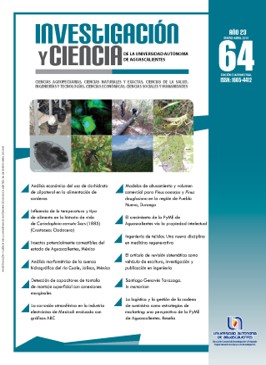Potentially edible insects of the state of Aguascalientes, Mexico
DOI:
https://doi.org/10.33064/iycuaa2015643591Keywords:
insects, anthropoentomophagy, AguascalientesAbstract
The insects represent an alternative case as human food because of their high protein level, abundance and easy recollection. In some localities of Mexico they are part of the traditional habits of alimentation; however, there are states as Aguascalientes, which
require more studies and food alternatives. In this work we sampled 24 localities in the 11 municipalities of the Aguascalientes state; collecting insects of entomophagic importance and applied 240 surveys to document the knowledge and entomophagic habits of the habitants. The present study list 32 species of potentially edible insects in Aguascalientes state, being the order Hymenoptera the one who presented more species richness and their families Formicidae and Apidae the most widely distributed.
Downloads
Metrics
References
• ARNETT, R. American insects: a Handbook of the Insects of American North of Mexico. 2 ed., Florida, US: CRC Press, 1985.
• ARNETT, R. y JAQUES, R. Simon and Schuster’s Guide to Insects. NY, US: Simon and Schuster Publisher. 521 pp., 1981.
• ARNETT, R. et al. American beetles, Polyphaga: Scarabaeoidea through Curculionidea. Volume 2. US: CRC Press, 2002.
• BOLTON, B. Identificaction Guide to the Ant Genera of the World. US: Harvard University Press, 1994.
• COSTA, E. y RAMOS ELORDUY, J. Los insectos comestibles de Brasil: etnicidad, diversidad e importancia en la alimentación. Boletín Sociedad Entomológica Aragonesa, 38: 423-442, 2006.
• DILLON, E. y DILLON, L. A Manual of Common Beetles of Eastern North America. US: Dover Publications, 1972.
• DURST, P. B. et al. Edable forest insects: Humans bite back/ Proceedings of workshop on Asia-Pacific resources and their potential for development. Food and Agricult., 2010.
• FERNÁNDEZ, F. (Ed.) Introducción a las hormigas de la región Neotropical. Bogotá, Colombia: Instituto de Recursos Biológicos Alexander von Humboldt, XXVI, 398 pp., 2003.
• GULLAN, P. y CRANSTON, P. The Insects, An Outline of Entomology. London, England: Chapman and Hall, pp. 3-6, 1994.
• KAMMINGA, K. et al. Field Guide to Stink Bugs of Agricultural Importance in the Upper Southern Region and Mid-Atlantic States. Virginia, US: Clemson University-IPM, 2009.
• LANDEROS TORRES, I. et al. Estudio etnográfico sobre el consumo de las “chicatanas” (Hymenoptera: Formicidae) en Huatusco, Veracruz. Folia Entomológica Mexicana, 44(2): 109-113, 2005.
• RAMOS, B. et al. Extracción de hormigas mieleras (Myrmecystus mexicanus): una reseña sobre el trabajo de campo, en Santo Domingo, Axpausco, Estado de México. Culinaria Revista Virtual Gastronómica, 5: 21-34, 2009.
• RAMOS ELORDUY, J. Edible insects. En Mesoamerican lore though, Mesoamerican Writing [CD-ROM] (pp. 87-89). New York, US: Mesolore/ Prolarty, Brown University, 1999.
• RAMOS ELORDUY, J. Threatened edible insects in Hidalgo, Mexico and some measures to preserve them. Journal of Ethnobilogy and Ethnomedicine, 2: 51, 2006.
• RAMOS ELORDUY, J. y PINO, J. Los insectos comestibles en el México antiguo. AGT Editor, S. A. 108 pp., 1989.
• RAMOS ELORDUY, J. y PINO, J. Contenido de vitaminas de algunos insectos comestibles de México. Revista de la Sociedad Química de México, 45(2): 66-67, 2001.
• RAMOS ELORDUY, J. y PINO, J. Los Coleóptera comestibles de México. [Serie Zoología]. Anales del Instituto de Biología de la Universidad Nacional Autónoma de México, 75(1): 149-183, 2004.
• RAMOS ELORDUY, J. et al. Biodiversidad antropoentomofágica de la región de Zongolica, Veracruz, México. Revista Biología Tropical, 56, 2008.
• RAMOS ELORDUY, J. et al. Conocimiento de la entomofauna útil en el poblado La Purísima, Palmar de Bravo, Estado de Puebla, México. Revista Biotemas, 20: 121-134, 2007.
• RAMOS ELORDUY, J. et al. Determinación de minerales en algunos insectos comestibles de México. Journal of the Mexican Chemical Society, 42(001): 18-33, 1998a.
• RAMOS ELORDUY, J. et al. Insectos comestibles del estado de México y determinación de su valor nutritivo. [Serie Zoología]. Anales del Instituto de Biología de la Universidad Autónoma de México, 69: 65-104, 1998b.
• RAMOS ELORDUY, J. et al. Protein content of some edible insects of Mexico. Journal of Ethnobiology, 4: 61-72, 1984.
• SCHUH, R. y SLATER, J. True bugs of the world (Hemiptera: Heteroptera) Classification and natural history. US: Comstock Publishing Associates, 1995.
• SLATER, J. y BARANOWSKI, R. How to know the true bugs (Hemiptera-Heteroptera). W.C. Brown Co., 256 pp., 1978.
De páginas electrónicas
• Instituto Nacional de Estadística, Geografía e informática (INEGI). Recuperado el 22 de junio de 2012, de http://www.inegi.mx
Downloads
Published
License
Copyright (c) 2015 Lizeth Puga Ayala, Jaime Escoto Rocha

This work is licensed under a Creative Commons Attribution-NonCommercial-ShareAlike 4.0 International License.
Las obras publicadas en versión electrónica de la revista están bajo la licencia Creative Commons Atribución-NoComercial-CompartirIgual 4.0 Internacional (CC BY-NC-SA 4.0)





